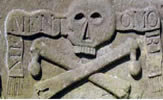Pitsligo Parish Kirkyard Peathill, Rosehearty
 The parish of Pitsligo was established on 28th June 1633 by Act of the Scottish Parliament, from the existing parishes of Aberdour, Fraserburgh and Tyrie following petition by Alexander Forbes of Pitsligo.
The parish of Pitsligo was established on 28th June 1633 by Act of the Scottish Parliament, from the existing parishes of Aberdour, Fraserburgh and Tyrie following petition by Alexander Forbes of Pitsligo.
It was the last parish erected within the Synod of Aberdeen.
The building of the kirk commenced prior to 1633, possibly as early as 1630. It became known to locals both as the ‘Visible Kirk’, especially by fishermen who used it as a landmark, and ‘Cant’s Kirk’, after Andrew Cant, the first Minister of the new parish.
The kirk structure was typically plain with harled elevations, relieved by red sandstone dressings at doors, windows and corners under a pitched roof which was originally thatched and later clad in Scotch slate.
The simplicity was contrasted by the beautifully ornate bell-cot thought to have been carved by a Dutch craftsman and dated 1635. This bell-cot was restored as part of the Historic Kirkyards project in 2003.
Gravestones
The kirkyard contains approximately 145 recumbent tombstones (tablestones) many of which exhibit outstanding examples of craftsmanship. The tablestone was a popular form of monument from about 1643 through to the 19th century. The earlier stones were ornamented with the symbols of mortality and immortality with later examples from the early 18th century incorporating trade emblems.
These stones were almost always supported on 4 or 6 low pedestals, which could also be highly decorated. Perhaps the most individual tombstone is that to Anna Sim who died in March 1724 which depicts a resurrection scene incorporating angels wearing kilts. This can be seen on the south west side of the old kirk.
Ministers of the Parish
Particular note is made here of three former Ministers of the Parish who for different reasons are associated with major historical events at home and abroad.
Andrew Cant (1634–39), the first Minister of the Parish, became a leading figure in the Covenanting movement. William Swan (1687–1716) was the last Episcopalian Minister when ejected for his Jacobite sympathies. William Mercer (1720–1767) was the father of Hugh, a graduate in medicine from Aberdeen University and supporter of the Jacobite cause who following Culloden left for America. Befriended by George Washington he became a General in the revolutionary army and was killed at the Battle of Princeton in 1777.
In order to secure the future of the loft on this site, the building passed into the ownership of the Pitsligo Castle Trust in 2002. Details for viewing are displayed on the kirk door.
Further information can be found in the leaflet Pitsligo Parish Kirkyard (PDF 338KB) produced by Aberdeenshire Council.
Information regarding the survey undertaken in 1998 on Pitsligo Parish Kirk can also be downloaded.
